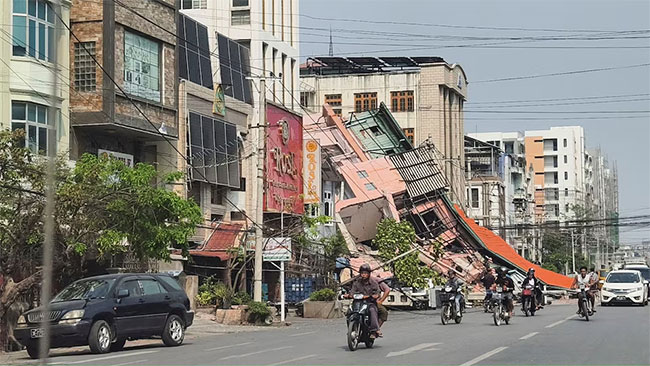Severe Earthquake Rattles Myanmar, Widespread Damage
A devastating earthquake has struck Myanmar, leaving a trail of destruction and prompting rescue operations across Southeast Asia. Amidst widespread infrastructure damage and numerous casualties, the international community watches closely.
Published March 29, 2025 - 00:03am

Image recovered from adaderana.lk
A devastating earthquake struck Myanmar on Friday, with the state-run MRTV reporting at least 144 people dead and 732 injured. The seismic activity was centered in Myanmar but felt widely across the Southeast Asian region, including Thailand and parts of China, highlighting the expansive reach and destructive potential of the event.
The epicenter of the quake was located near the city of Sagaing in Myanmar, registering a magnitude of 7.7 on the Richter scale, according to the United States Geological Survey (USGS). This significant tremor was followed by a substantial aftershock with a magnitude of 6.4, which compounded the destruction and panic.
In Myanmar, the quake caused considerable damage to infrastructure, including the collapse of several buildings and damage to roads connecting major cities like Mandalay and Yangon. In Mandalay, a partial mosque collapse contributed to multiple fatalities. The architectural damage extended to cultural heritage sites, including parts of the Mandalay Palace, underscoring the extensive impact on the country's heritage.
The situation in Thailand is similarly dire, with significant destruction reported in Bangkok. A 30-story building under construction collapsed, leaving rescuers scrambling to find and extract workers. The Thai authorities declared a state of emergency in Bangkok and advised citizens to stay clear of tall structures, anticipating further seismic activity.
Throughout the region, the earthquake's ripple effects were felt in countries as far as Bangladesh, India, Laos, and China, where minor injuries and structural tremors were reported in places like Yunnan province. This cross-border impact underscores the widespread scent of urgency and panic that filled the air following the quake.
Amidst this turmoil, rescue operations are ongoing, with teams deployed in Myanmar and Thailand working tirelessly to uncover those trapped in debris. In Yangon, emergency services are focused on stabilizing damaged structures to prevent further collapses.
Compounding the difficulty is Myanmar's political climate, still fragile after the 2021 coup. The ability of the military government to coordinate effective rescue efforts remains in question, with international offers of assistance pending acceptance amidst political tensions.
Even as the international community watches in concern, local governments are prioritizing immediate rescue and relief efforts. One key focus is ensuring the availability of medical aid to the injured and shelter for those displaced. However, the scale of destruction poses challenges to these efforts, with ongoing aftershocks threatening to exacerbate an already dire situation.
This seismic event not only exposes the vulnerabilities of the infrastructure within Myanmar and surrounding regions but also serves as a stark reminder of the power of natural phenomena over human settlements. As rescue efforts continue, the world's attention remains on the unfolding humanitarian needs and the long-term recovery that will be required in the aftermath of this disaster.







